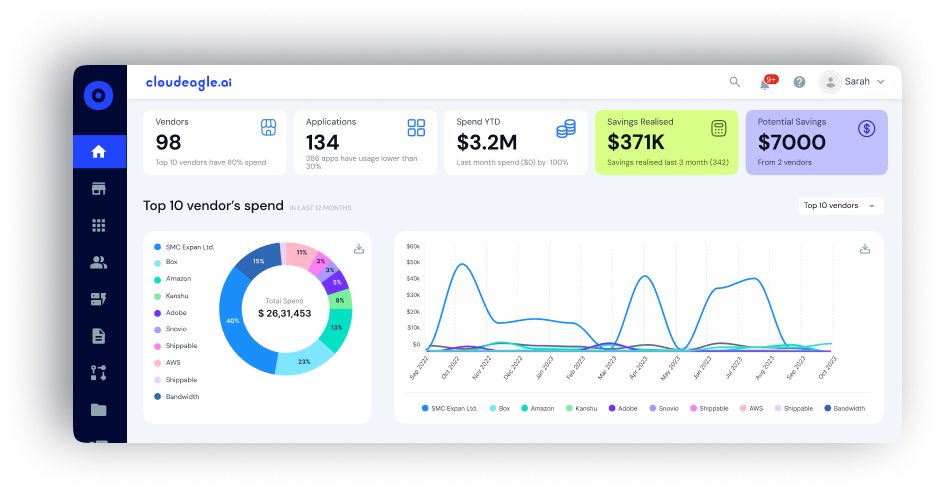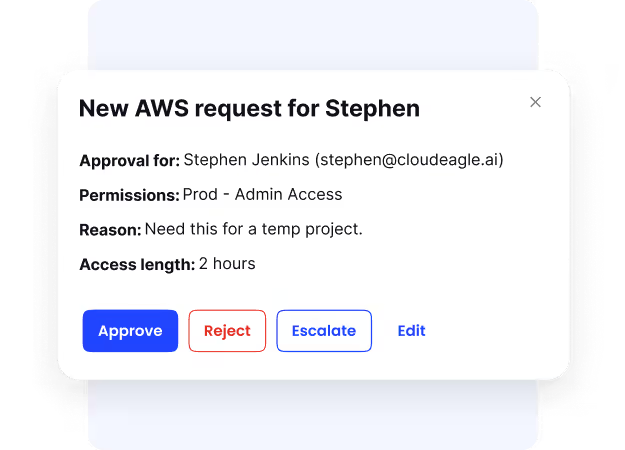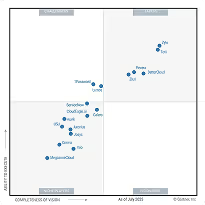HIPAA Compliance Checklist for 2025

Are you sure your SaaS tools are fully compliant?
As enterprises continue to adopt more SaaS applications and AI-driven tools, keeping track of compliance requirements has never been more challenging. With regulations such as SOC 2, ISO 27001, GDPR, and HIPAA, ensuring that every tool meets security and compliance standards is crucial to avoid costly penalties and data breaches.
CloudEagle.ai’s IGA report says 60% of apps operate outside IT teams’ visibility, exposing enterprises to significant security and compliance risks. As the SaaS usage grows, so does the complexity of managing it, making it easy for enterprises to overlook critical compliance details.
Implementing a strong SaaS compliance strategy is crucial to staying ahead. By automating and centralizing visibility into your SaaS stack, you can reduce risks and pass audits confidently. Let’s explore the top 7 SaaS compliance best practices to safeguard your business.
TL;DR
- Centralize your SaaS inventory to track all apps, ensuring visibility and simplifying audits.
- Enforce role-based access control and conduct regular access reviews to prevent unauthorized access.
- Automate offboarding and set time-based access for contractors to maintain security and compliance.
- Track vendor certifications like SOC 2, ISO 27001, and GDPR to ensure all third-party tools meet security standards.
- Automate contract renewals to avoid missed deadlines and ensure compliance with vendor agreements.
What Is SaaS Compliance?
SaaS compliance is the framework of processes and controls that ensure your SaaS applications meet security, privacy, and regulatory standards. It verifies that every app and vendor aligns with your organization’s risk policies and external SaaS compliance requirements such as SOC 2, ISO 27001, HIPAA, and GDPR.
Effective SaaS compliance management ensures that access is properly governed, vendor data is protected, and audit evidence is always available. With hundreds of interconnected SaaS systems in use, dedicated SaaS compliance software helps automate discovery, documentation, and monitoring, making compliance scalable and repeatable.
Why SaaS Compliance Matters?
As enterprises rely on multiple SaaS apps, ensuring these tools meet security and regulatory standards is crucial to protect data, maintain trust, and avoid penalties.
Here’s why SaaS compliance matters:
1. Protects Sensitive Data: Ensuring that SaaS applications comply with data protection regulations like SOC 2, ISO 27001, HIPAA, and GDPR helps safeguard sensitive customer and business data from breaches and unauthorized access.
2. Meets Legal and Regulatory Requirements: With an increasing number of data privacy laws and regulations, maintaining SaaS compliance ensures your business meets these requirements, helping you avoid costly fines and penalties.
For instance, non-compliance can lead to heavy fines, such as €20 million or 4% of annual turnover under GDPR, or up to $50,000 per violation with HIPAA, highlighting the importance of SaaS compliance.
3. Mitigates Risk: Non-compliance can expose enterprises to security vulnerabilities, legal issues, and reputational damage. SaaS compliance minimizes the risk by establishing consistent policies and controls across all applications.
4. Streamlines Audits: A well-managed SaaS compliance strategy simplifies audit processes by providing visibility into your SaaS stack, ensuring that all applications are compliant, and generating necessary reports with ease.
5. Improves Trust: Demonstrating SaaS compliance builds trust with customers, vendors, and stakeholders. It shows your commitment to securing their data and maintaining transparent and responsible business practices.
7 SaaS Compliance Best Practices
To ensure your business stays secure and compliant, here are the 7 essential SaaS compliance best practices you should follow.
1. Centralize Your SaaS Inventory
You can’t protect what you don’t know exists. A complete inventory of all SaaS apps is the foundation of SaaS compliance management. A centralized inventory ensures compliance visibility and prepares your organization for any SaaS security compliance audit.
Checklist:
- Track all vendors, contracts, users, and licenses.
- Include free-tier, AI, and non-SSO apps.
- Continuously monitor usage and ownership changes.
2. Enforce Role-Based Access and Periodic Reviews
Defining who can access what, and verifying it regularly, is a core SaaS compliance requirement. This prevents privilege creep and keeps your SaaS compliance audit process clean and transparent.
Checklist:
- Assign roles based on department, function, and risk.
- Automate quarterly or event-driven access reviews.
- Support reviewer decisions with usage data and risk scores.
3. Secure Offboarding and Temporary Access Controls
Access mismanagement is one of the leading causes of non-compliance. Automation tools like CloudEagle.ai can detect lingering access across all connected apps, ensuring compliance and security integrity.
Checklist:
- Deprovision access instantly after termination.
- Set time-bound access for contractors and interns.
- Auto-revoke idle or inactive accounts.
4. Track Vendor Compliance Certifications
Vendors play a major role in your organization’s SaaS security compliance. This step ensures every vendor in your SaaS ecosystem meets external SaaS compliance requirements.
Checklist:
- Maintain up-to-date SOC 2, ISO 27001, HIPAA, and GDPR documents.
- Get alerts when certifications or DPAs expire.
- Keep all compliance data easily searchable and linked to contracts.
5. Automate Contract and Renewal Oversight
Manual renewal tracking often leads to missed opt-outs and undocumented approvals. Automated SaaS compliance tools help align financial accountability with security and governance controls.
Checklist:
- Store contracts with searchable metadata (SLAs, renewal dates).
- Automate renewal alerts and workflows.
- Verify vendor pricing, compliance, and performance before renewal.
6. Monitor Shadow IT and Unauthorized SaaS Use
Shadow IT is the hidden compliance risk of every organization. Tools like CloudEagle.ai detect unauthorized SaaS use and generate risk scores to help prioritize remediation.
Checklist:
- Detect tools accessed outside SSO or procurement.
- Flag credit card-based or browser plugin purchases.
- Monitor AI tool adoption for compliance and data risk.
7. Maintain Audit-Ready Logs and Reporting
Documentation is key to every SaaS compliance audit. Consistent logging ensures your organization stays audit-ready year-round.
Checklist:
- Store all logs of access reviews, provisioning, and license changes.
- Record approval workflows and user activities.
- Generate exportable reports for SOC 2, ISO, and GDPR audits.
How CloudEagle.ai Helps in SaaS Compliance Management?
SaaS compliance goes beyond simple checklists; it's about continuous monitoring, access control, and vendor management across your entire SaaS ecosystem.
To do so effectively, you need an advanced SaaS management and access governance tool like CloudEagle.ai. With CloudEagle.ai, compliance is seamless and proactive, not reactive.
Here’s how it helps with compliance management:
1. Centralized SaaS Compliance Inventory
CloudEagle.ai builds a live inventory of all SaaS and AI tools, including app compliance posture, contract status, user access, and review history.

How it helps:
- Eliminates spreadsheet-based tracking.
- Surfaces unvetted vendors automatically.
- Helps define audit scope in seconds.
- Gives GRC teams a real-time compliance posture.
- Lays the foundation for scalable compliance ops.
2. Access Review Automation with Audit Trails
According to CloudEagle.ai’s IGA report, 95% of organizations still perform access reviews manually, which is not efficient or scalable.
With CloudEagle.ai, you can automate periodic access reviews, capture reviewer decisions, and store all actions with timestamps. This streamlined process makes it easy to validate controls under frameworks like SOC 2, ISO, GDPR, HIPAA, and more, ensuring a more efficient and compliant access management system.

How it helps:
- Satisfies mandatory access control requirements.
- Reduces human error and review delays.
- Ensures audit-ready evidence is always on hand.
- Makes least-privilege enforcement provable.
- Simplifies compliance workflows across teams.
Know how Dezerv automated its app access review process with CloudEagle.ai.
4. Shadow IT Discovery for AI & Unmanaged Tools
CloudEagle.ai detects unsanctioned tools or shadow IT, especially AI apps or browser-based platforms, that bypass formal vetting and authentication policies.

How it helps:
- Reduces compliance risk from unapproved tools.
- Extends policy coverage to the entire SaaS footprint.
- Prevents data leakage via unmanaged vendors.
- Helps IT regain control over distributed adoption.
- Provides compliance context for all discovered tools.
5. Contract Metadata & Renewal Oversight
CloudEagle.ai captures renewal dates, SLAs, opt-out windows, and compliance terms in a searchable contract repository, with alerts to avoid risky renewals.

How it helps:
- Prevents lock-in with non-compliant vendors.
- Ensures SLAs and DPAs are always accessible.
- Reduces legal and procurement review cycles.
- Helps maintain up-to-date records for audits.
- Increases visibility into compliance-linked spend.
6.Just-In-Time Access Control
CloudEagle.ai supports Just-In-Time (JIT) access control, allowing you to set short time limits for user access. This feature is critical for frameworks that require access to be minimal, justified, and time-bound, ensuring compliance with least-privilege access policies.

How it helps:
- Prevents privilege creep and stale permissions.
- Aligns access with compliance best practices.
- Simplifies temporary access for audits or projects.
- Improves overall security posture.
- Helps meet least-privilege access standards.
7. Compliance Reporting & Dashboards
Role-based dashboards and one-click exportable reports give GRC, security, and IT teams full transparency into controls, gaps, and audit status.
How it helps:
- Speeds up preparation for audits and assessments.
- Reduces manual report creation time.
- Ensures evidence is consistent and easy to review.
- Improves cross-functional alignment during audits.
- Enhances visibility for leadership and compliance leads.
Explore how Treasure Data enhanced access management and reporting with CloudEagle.ai.
3. Vendor Compliance Certification Tracking
Each vendor is tagged with current ISO, GDPR, HIPAA, and SOC 2 certifications. CloudEagle.ai alerts you when certifications are missing, outdated, or about to expire.
Cybersecurity Expert Mary K. Pratt says:
"Organizations that want to prove to others – and to themselves – that they have a solid cybersecurity and data privacy program will undergo a SOC 2 audit. As such, a SOC 2 audit is a big deal, and it’s demanding, and it requires some serious preparation."
How it helps:
- Flags third-party compliance gaps early.
- Supports DPA and vendor due diligence processes.
- Helps maintain clean vendor documentation.
- Minimizes audit exceptions and surprises.
- Keeps legal and procurement aligned.
Join Karl Haviland for an insightful discussion on SaaS governance, AI, and cloud-first strategies, and learn how to scale tech innovations effectively.
Conclusion
As we move into 2025, SaaS compliance has become more than just a checkbox; it's a key driver of business success. By implementing the best practices and using automated SaaS compliance software, IT and Security teams can ensure that all vendors, apps, and users meet compliance standards efficiently.
With solutions like CloudEagle.ai, enterprises can streamline their SaaS compliance processes, stay audit-ready, and continue to innovate without compromising on security or governance.
Ready to take charge of your enterprise’s compliance management? Schedule a demo with CloudEagle.ai today and discover how simple compliance can be.
FAQ
1. What is SaaS compliance?
SaaS compliance refers to ensuring all SaaS applications meet security, privacy, and regulatory standards like SOC 2, ISO 27001, and HIPAA.
2. What is the rule of 40 in SaaS?
The “Rule of 40” is a financial benchmark for SaaS companies—if a company’s growth rate plus profit margin is 40% or higher, it’s considered financially healthy.
3. What is ISO compliance for SaaS?
ISO 27001 compliance ensures SaaS security compliance by validating that vendors have proper controls for data protection, confidentiality, and risk management.
4. What is SOC 2 compliance for SaaS?
SOC 2 compliance verifies that a SaaS provider maintains secure systems for handling customer data based on trust principles like security, availability, and privacy.
5. What are the 5 key security elements of the SaaS model?
The five key security elements of the SaaS model are data protection and encryption, access control, compliance documentation, vendor monitoring, and continuous auditing and reporting.

%201.svg)










.avif)




.avif)
.avif)




.png)









